South Carolina is a state in the southeastern region of the United States, and it is home to a wide variety of bird species. From the bright feathers of the Northern Cardinal to the haunting call of the Great Horned Owl, the birds of South Carolina are a source of beauty, wonder, and diversity.
From shorebirds to raptors, songbirds to game birds, the birds of South Carolina are an important part of the ecosystem of the state and add color and life to its natural scenery.
1. Carolina Wren
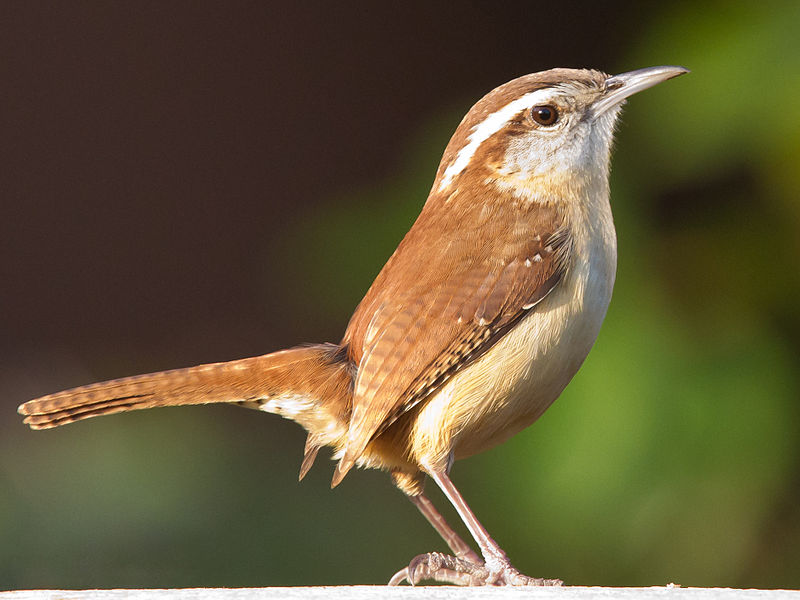
The Carolina wren (Thryothorus ludovicianus) is a medium-sized bird that can be found in the eastern United States, southern Ontario and northeast Mexico.
They typically live in dense shrubbery or thickets near open areas such as gardens, parks and woodland edges.
These birds are quite adaptable when it comes to nesting sites – they will build their nests anywhere from tree cavities to manmade boxes.
Their diet consists of insects, spiders and other invertebrates which they forage for on the ground or among vegetation.
The males have an unmistakable song made up of loud whistles interspersed with trills reminiscent of laughter; you’ll often find these cheerful little birds singing away during early morning hours.Scientific classification:
| Kingdom | Animalia |
| Phylum | Chordata |
| Class | Aves |
| Order | Passeriformes |
| Family | Troglodytidae |
| Genus | Thryothorus Vieillot, 1816[2] |
| Species | T. ludovicianus |
2. Northern Cardinal

The Northern Cardinal is a beautiful bird, easily identified by its bright red plumage. It can be found in the eastern United States from Maine to Minnesota and south through Mexico and Belize.
Along with its striking colouration, it has a distinctive crest on its head and sharp black facial markings around the eyes.
Despite their small size (measuring 7-9 inches) they are very vocal birds – males sing persistently throughout springtime to attract mates or proclaim their territory.
They typically feed on insects, seeds and fruits but also enjoy suet at backyard bird feeders.
The female is less brightly coloured than her mate but still stands out among other songbirds due to her warm brownish-red feathers.
Cardinals pair for life so you may often see them together in your garden or neighbourhood park.Scientific classification:
| Kingdom | Animalia |
| Phylum | Chordata |
| Class | Aves |
| Order | Passeriformes |
| Family | Cardinalidae |
| Genus | Cardinalis |
| Species | C. cardinalis |
3. Carolina Chickadee
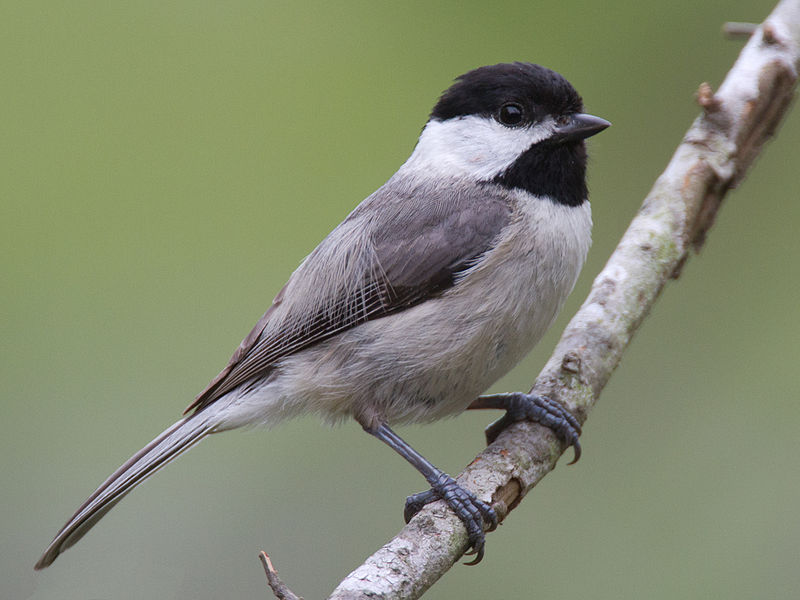
The Carolina Chickadee is a small passerine bird found in the tit family Paridae. It stands out for its distinct black and white, grey-brown feathers with an offwhite underside.
This species can be spotted by its call: “chick-a-dee”. The American Ornithologists’ Union has classified them into their own genus called Poecile as they differ from other tits due to both genetic data and morphology.
These birds are found all over North America, living in wooded areas near open fields or water sources.
They feed on insects such as caterpillars but also have been known to eat suet at backyard feeders during winter months when food is scarce.Scientific classification:
| Kingdom | Animalia |
| Phylum | Chordata |
| Class | Aves |
| Order | Passeriformes |
| Family | Paridae |
| Genus | Poecile |
| Species | P. carolinensis |
4. House Finch

The House Finch is a species of finch native to western North America and has been introduced in the eastern half of the continent as well as Hawaii.
It’s an average-sized finch with adults measuring 12.5 – 15 cm (5 – 6 inches) long and having wingspans between 20 – 25 cm (8 – 10 inches).
The upperparts are brown, while its underparts range from pale grayish white to yellow depending on subspecies.
Its face is streaked or spotted with reddish coloration; males typically have brighter plumage than females due to sexual dimorphism.
They’re mostly found near human habitations such as farms and gardens where they feed on grains, fruits, insects etc., making them very popular among birders who want something colorful for their backyard.Scientific classification:
| Kingdom | Animalia |
| Phylum | Chordata |
| Class | Aves |
| Order | Passeriformes |
| Family | Fringillidae |
| Subfamily | Carduelinae |
| Genus | Haemorhous |
| Species | H. mexicanus |
5. Blue Jay

The Blue Jay is a beautiful bird that resides in eastern and central United States, as well as Newfoundland Canada.
They have an unmistakable blue colored plumage with white markings on their heads and wings.
These birds are highly adaptable to different habitats ranging from deciduous forests to urban areas.
As part of the Corvidae family, they are known for being intelligent problem solvers who will often use tools or mimic vocalizations of other species like hawks when defending their territories.
Their diet consists mostly of insects, seeds and nuts but can also include small vertebrates such as frogs or lizards if food resources become scarce.
Overall these birds provide much needed color to our environment while playing important roles in maintaining healthy ecosystems through pollination services and seed dispersal activities.Scientific classification:
| Kingdom | Animalia |
| Phylum | Chordata |
| Class | Aves |
| Order | Passeriformes |
| Family | Corvidae |
| Genus | Cyanocitta |
| Species | C. cristata |
6. Tufted Titmouse

The Tufted Titmouse is a small, cheerful songbird found in North America. It’s part of the tit and chickadee family (Paridae).
It has distinctive white feathers around its eyes, grey-brown wings and upper body, with a pale tan underside.
Its most notable feature is the black crest on top of its head that gives it an inquisitive look. The male also sports a pinkish breast which can be seen.
When singing from high perches during the spring months. This bird loves to eat sunflower seeds or suet at backyard feeders as well as insects in summertime.
You may even see them poking into crevices and bark looking for food.
They are quite social birds too, being often spotted in mixed flocks alongside other species such as nuthatches and woodpeckers all year round.Scientific classification:
| Kingdom | Animalia |
| Phylum | Chordata |
| Class | Aves |
| Order | Passeriformes |
| Family | Paridae |
| Genus | Baeolophus |
| Species | B. bicolor |
7. Red-Bellied Woodpecker
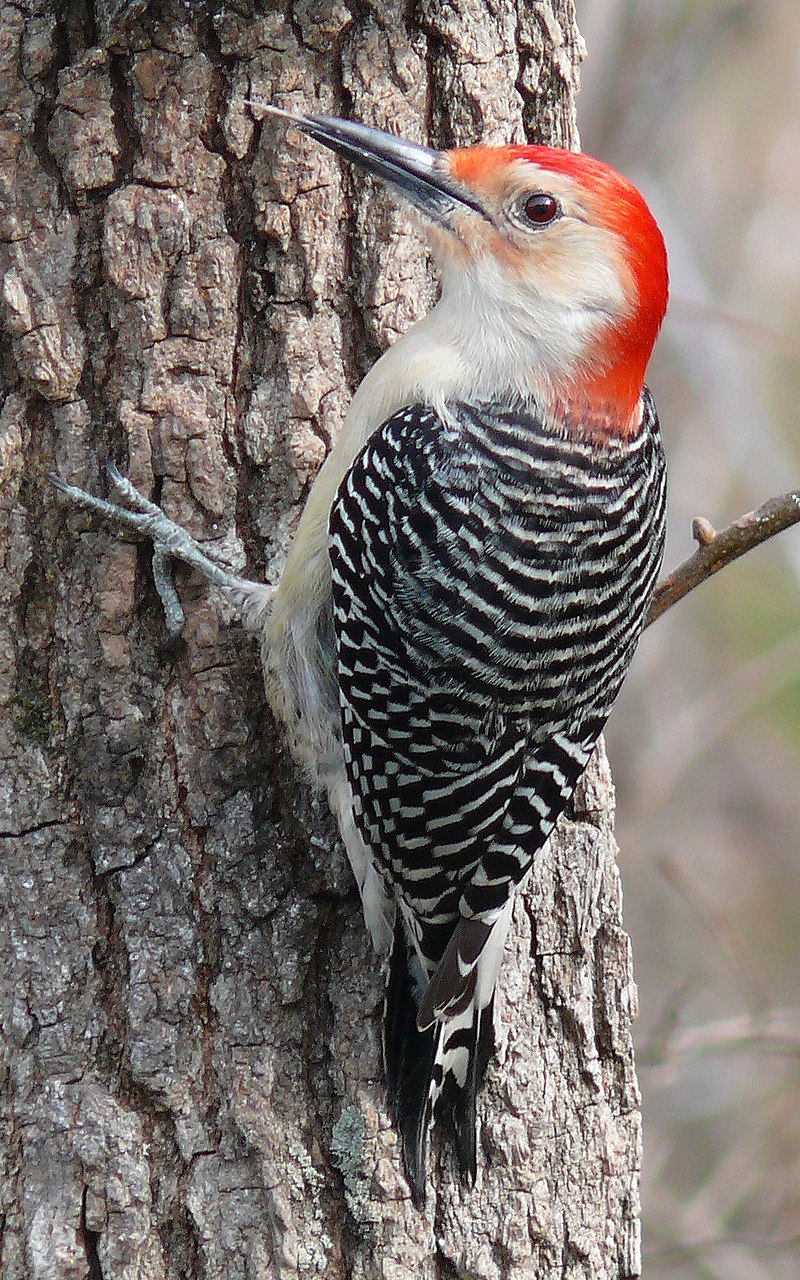
The Red-bellied woodpecker is a beautiful bird with an orange-red crown and nape. It breeds mainly in the eastern United States, ranging from Florida to Canada.
This medium-sized woodpecker of the family Picidae has black wings, white stripes on its back and tail feathers that are barred with black.
Its underside is mostly pale yellow or white but it also features some red coloration around its neck area.
Despite this subtle red hue, it should not be mistaken for the entirely red head and neck belonging to the Red-headed woodpecker of the same genus Melanerpes carolinus.
The Red bellied Woodpeckers diet consists primarily of insects such as ants, beetles and grasshoppers along with nuts fruits berries and tree sap which they will feed upon during different times throughout their life cycle.Scientific classification:
| Kingdom | Animalia |
| Phylum | Chordata |
| Class | Aves |
| Order | Piciformes |
| Family | Picidae |
| Genus | Melanerpes |
| Species | M. carolinus |
8. American Robin

The American robin is a migratory bird, belonging to the true thrush genus and Turdidae family.
It was named after its European counterpart due to the similar reddish-orange breast they both possess; however, they are not related closely.
This species can be seen through most of North America during winter months, as well as in parts of Mexico and Central America where it also breeds.
They have plump bodies with gray upperparts and white underparts that vary from yellow on their throats down to orange toward their bellies.
Robins feed on fruits such as berries or insects like worms which makes them an important part of ecosystems by helping disperse seeds naturally throughout these areas.Scientific classification:
| Kingdom | Animalia |
| Phylum | Chordata |
| Class | Aves |
| Order | Passeriformes |
| Family | Turdidae |
| Genus | Turdus |
| Species | T. migratorius |
9. Mourning Dove
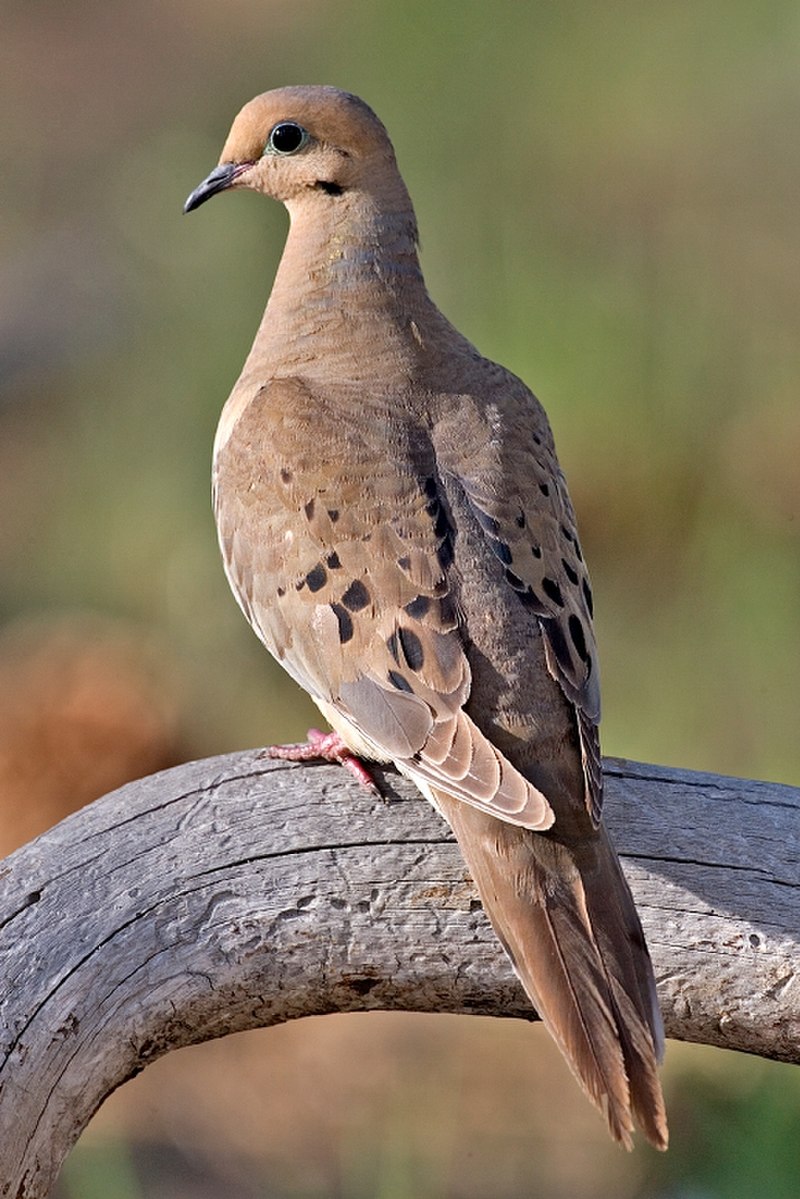
The Mourning Dove is a breathtakingly beautiful bird. It has stunning gray and brown feathers with white tipped wings, giving it an elegant appearance. Its long tail also adds to its graceful look in flight.
A symbol of peace and serenity, they are abundant across North America and can be found in gardens or open fields throughout the year.
As well as being popular game birds for hunters, they feed on grains such as wheat and millet providing important food sources for wildlife species including foxes, coyotes, skunks and raccoons.
These doves have a distinctive cooing sound that can often be heard echoing through woodlands during summer evenings making them one of nature’s greatest treasures.Scientific classification:
| Kingdom | Animalia |
| Phylum | Chordata |
| Class | Aves |
| Order | Columbiformes |
| Family | Columbidae |
| Genus | Zenaida |
| Species | Z. macroura |
10. Eastern Bluebird
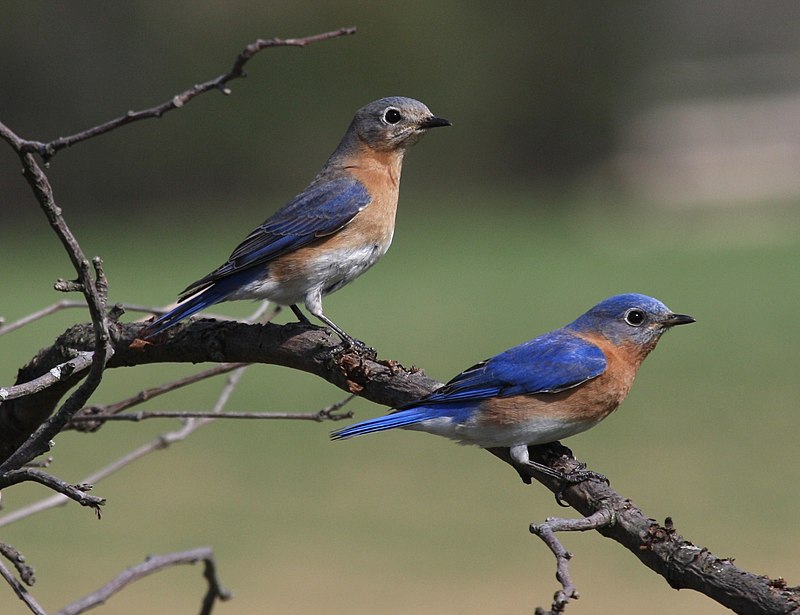
The Eastern bluebird is a small migratory thrush that can be found in open woodlands, farms and orchards across North America.
The male has bright-blue breeding plumage which makes it easily recognizable by birders.
It produces melodious songs such as jeew, chir-wi and chiti WEEW wewidoo.
This popular species was declared the state bird of Missouri back in 1927 due to its beauty and charm.
In addition to being beautiful, these birds are also beneficial for farmers because they eat insects like grasshoppers and beetles which damage crops.
They nest in cavities so providing nesting boxes helps them thrive even more.
With their vibrant colors, sweet melodies and helpful nature it’s easy to see why the Eastern Bluebird is beloved worldwide.Scientific classification:
| Kingdom | Animalia |
| Phylum | Chordata |
| Class | Aves |
| Order | Passeriformes |
| Family | Turdidae |
| Genus | Sialia |
| Species | S. sialis |
11. American Goldfinch
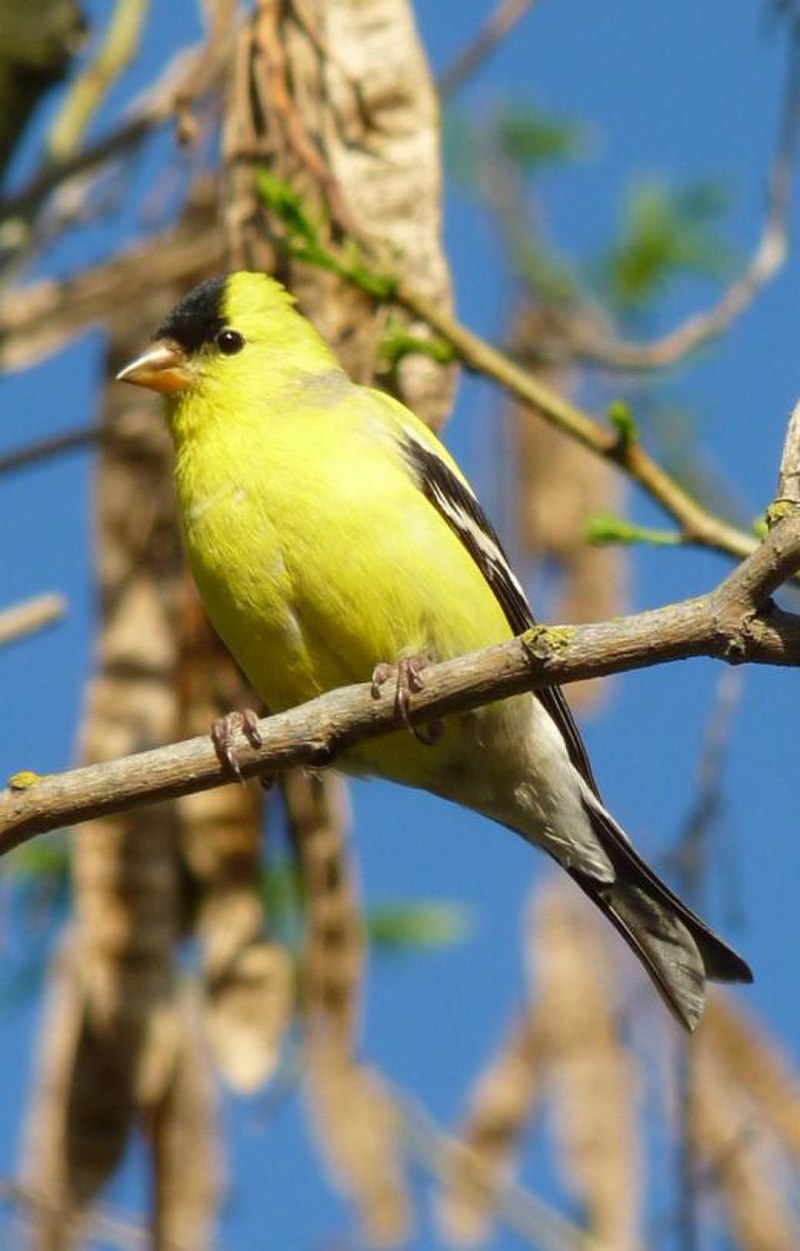
The American goldfinch is a small North American bird in the finch family. Males are vibrant yellow with black wings and tail, while females are duller in colouration.
It migrates from mid-Alberta to North Carolina during breeding season, south of Canada–United States border to Mexico for its wintering grounds.
The only finch which undergoes complete molt every year, it displays sexual dichromatism where males have brighter colours than their female counterparts.
They feed mainly on seeds but also eat insects such as aphids and caterpillars when raising youngs; they often occur near thistles or other plants that produce viable seed heads.
Their call consists of an array of chirps and trills making them quite conspicuous.Scientific classification:
| Kingdom | Animalia |
| Phylum | Chordata |
| Class | Aves |
| Order | Passeriformes |
| Family | Fringillidae |
| Subfamily | Carduelinae |
| Genus | Spinus |
| Species | S. tristis |
12. Downy Woodpecker
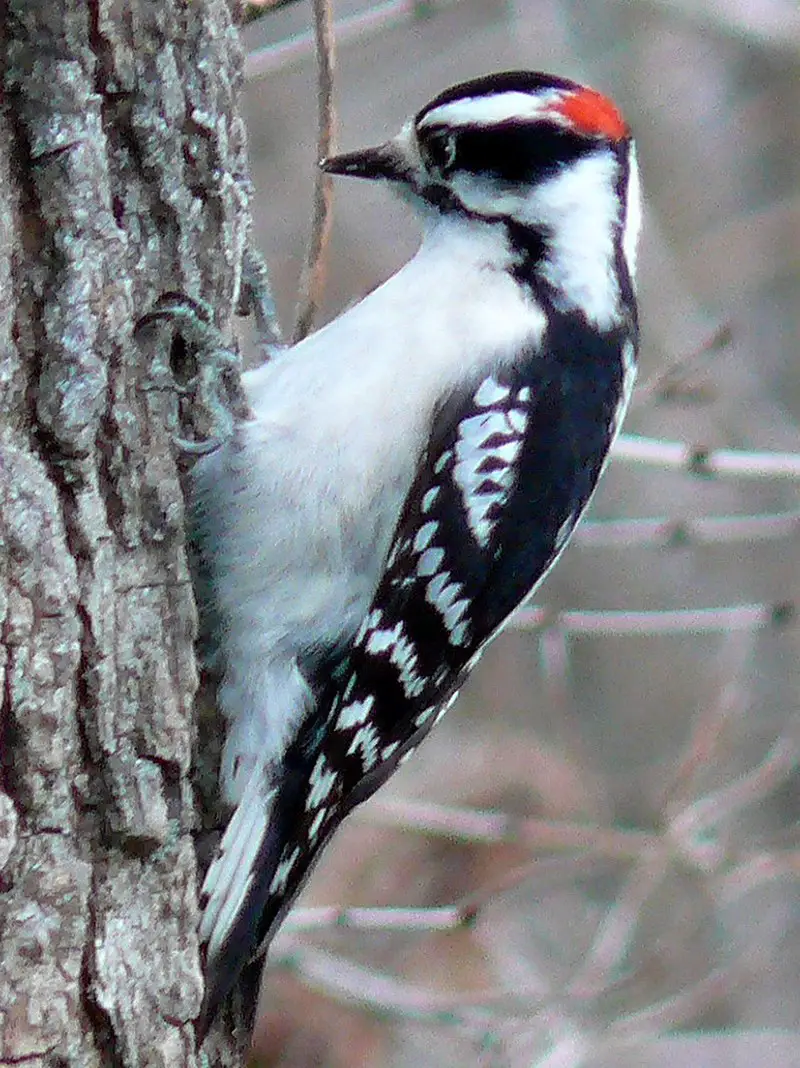
The downy woodpecker is a small species of woodpecker found in North America. Growing up to 7 inches long, it can be identified by its white belly and spotted wings.
It inhabits forests throughout the United States and Canada, with the exception of deserts in the southwest and northern tundra.
This bird nests in tree cavities and feeds mostly on insects but will supplement its diet with fruit or nuts when available.
The Downy Woodpecker has an unmistakable call that sounds like a loud ‘pik-er’, similar to other members of its family such as the Hairy Woodpecker.Scientific classification:
| Kingdom | Animalia |
| Phylum | Chordata |
| Class | Aves |
| Order | Piciformes |
| Family | Picidae |
| Genus | Dryobates |
| Species | D. pubescens |
13. Northern Mockingbird
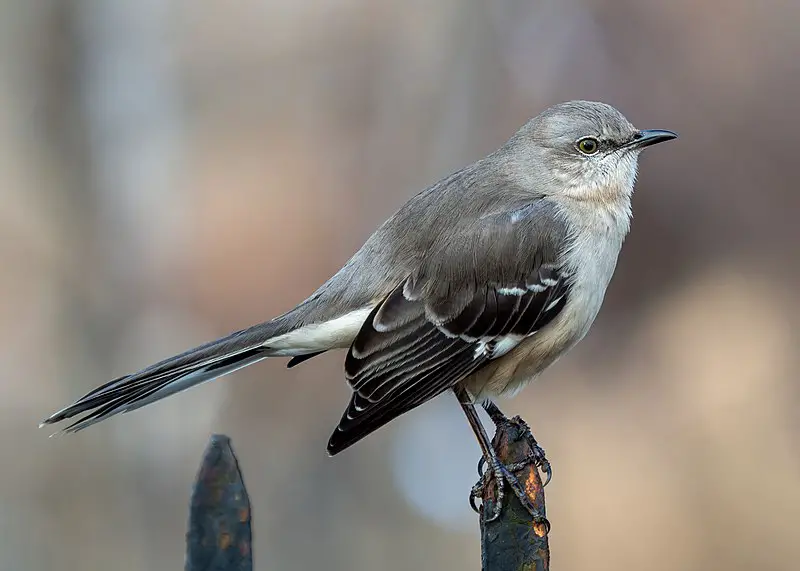
The northern mockingbird is a common fixture in North American skies. It has greyish-brown upperparts and a paler underside with white wing patches, and its distinctive long tail makes it easy to spot.
This adaptable bird can often be seen singing from the tops of trees or fences, though it rarely strays into Europe.
The species was first described by Carl Linnaeus in his 1758 Systema Naturae as Turdus polyglottos – aptly named for their remarkable ability to mimic other birds’ songs.
Northern mockingbirds typically live on insects, fruits, berries and seeds but they will also happily scavenge food scraps left out by humans.
With its beautiful song and striking plumage this beloved avian makes an important contribution to our environment.Scientific classification:
| Kingdom | Animalia |
| Phylum | Chordata |
| Class | Aves |
| Order | Passeriformes |
| Family | Mimidae |
| Genus | Mimus |
| Species | M. polyglottos |
14. Yellow-Rumped Warbler

The Yellow-rumped Warbler (Setophaga coronata) is a migratory bird species that can be found throughout North America.
It has an extensive range, from the Pacific and Atlantic coats of the US to Canada and Central America, with a concentration in northern areas during breeding season.
These birds migrate southwards for wintering grounds where they find plentiful food sources such as insects and berries.
They are easily identified by their yellow patches on either side of their tails, along with white underparts, gray back feathers and two distinct crown stripes.
One black or greyish-brown above the eyes extending towards its neck banded in yellow or light brown colouration.
Furthermore, these warblers have strong legs which allow them to cling onto branches while hunting for prey making them adept at maneuvering through tree cover quickly.
All together this makes the Yellow-rumped Warbler an attractive backyard visitor year round.Scientific classification:
| Kingdom | Animalia |
| Phylum | Chordata |
| Class | Aves |
| Order | Passeriformes |
| Family | Parulidae |
| Genus | Setophaga |
| Species | S. coronata |
15. Woodpeckers
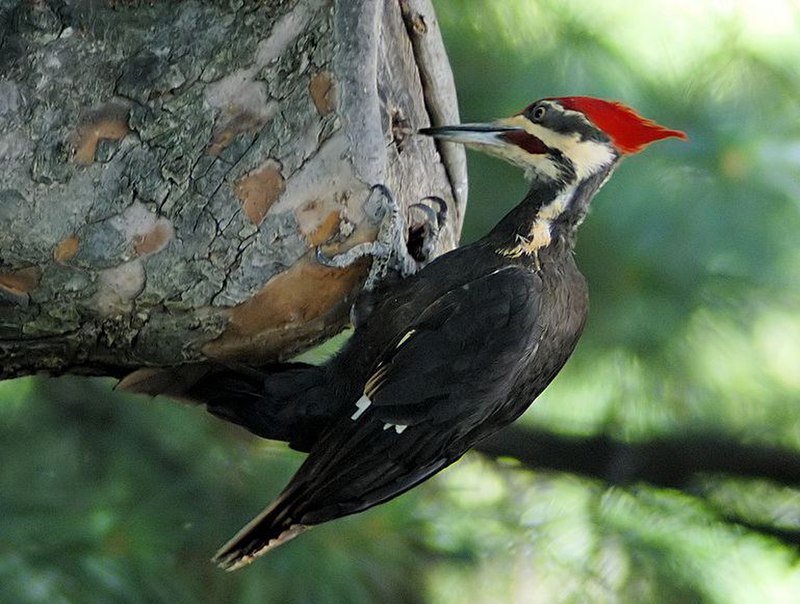
Woodpeckers are an incredibly diverse bird species, found all over the world except for Australia, New Guinea, New Zealand, Madagascar and the extreme polar regions.
They live in a variety of habitats including forests and woodlands but also rocky hillsides and deserts with no trees.
Their beaks are adapted to pecking at tree bark to find food such as insects or larvae hidden beneath it while they use their long tongues to catch them from deep inside crevices.
Woodpeckers have tough skulls that protect their brains from impact when they bang into things during drumming – a behaviour used by males for territorial signalling and reproduction purposes which is done using strong rapid beats against hollow objects like dead branches or metal poles.Scientific classification:
| Kingdom | Animalia |
| Phylum | Chordata |
| Class | Aves |
| Order | Piciformes |
| Infraorder | Picides |
| Family | Picidae Leach, 1820 |
16. Brown Thrasher
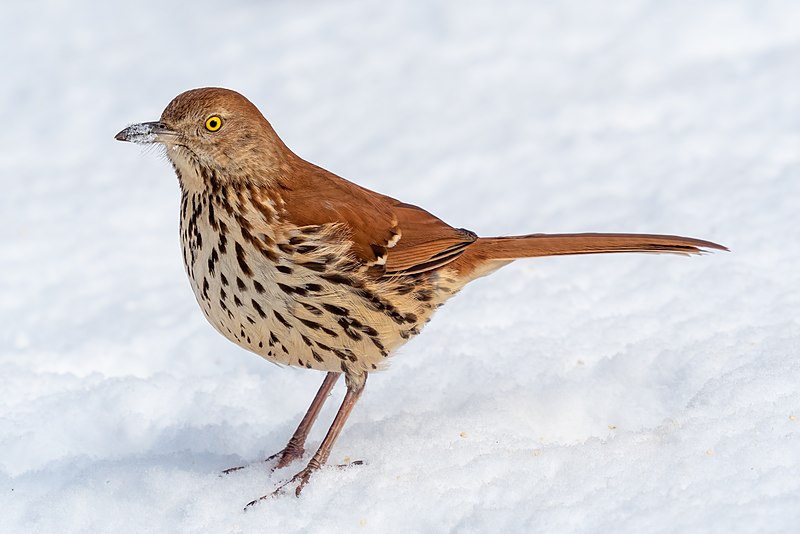
The brown thrasher is a member of the Mimidae family, along with catbirds and mockingbirds. It is found throughout much of North America in the eastern and central United States as well as southern and central Canada.
The only place that it does not inhabit is west of the Rockies or in Central Texas.
This bird can be identified by its reddish-brown back feathers, white underbelly and long tail that often drags behind it when walking on the ground hunting for food like insects, fruits or berries.
Its loud song consists of over 2000 different notes.
Brown Thrashers are known to build nests close to human activity which makes them easily accessible for observation making them a popular backyard species among many birdwatchers.Scientific classification:
| Kingdom | Animalia |
| Phylum | Chordata |
| Class | Aves |
| Order | Passeriformes |
| Family | Mimidae |
| Genus | Toxostoma |
| Species | T. rufum |
17. White-Breasted Nuthatch

The White-breasted Nuthatch is a medium-sized bird belonging to the nuthatch family Sittidae. It measures around 15.5 cm in length and its colour varies throughout its range.
Males have a light blue-grey upperpart, with black crown and nape whereas females have a dark grey crown instead of black one.
The underparts are whitish, with reddish tinge on sides and flanks while the bill is short and stout with pale base near eyes which can be yellow or white depending upon geographic location..
This species feeds mainly on insects but will also eat seeds, nuts and berries when available.
They prefer open woodlands where they often climb trees searching for food along trunks as well as branches underneath bark crevices creating their nest there too.Scientific classification:
| Kingdom | Animalia |
| Phylum | Chordata |
| Class | Aves |
| Order | Passeriformes |
| Family | Sittidae |
| Genus | Sitta |
| Species | S. carolinensis |
18. American Crow

The American crow is a large bird of the Corvidae family, native to most parts of North America.
It is similar in size and structure to its European counterpart, the carrion crow, as well as Eurasia’s hooded crow.
The three species occupy the same ecological niche, but are distinguishable by their differences in appearance.
American crows have black feathers covering their entire body with wingspan averaging between 17-21 inches wide for males and 16-19 inches for females.
They feed on insects such as grasshoppers, beetles and caterpillars; they also eat grains from fields or abandoned farms during winter months when food sources become scarcer.
In addition to feeding habits American crows can be identified by their distinct call which resembles a “caw” sound that travels long distances over open terrain making them popular among birdwatchers.Scientific classification:
| Kingdom | Animalia |
| Phylum | Chordata |
| Class | Aves |
| Order | Passeriformes |
| Family | Corvidae |
| Genus | Corvus |
| Species | C. brachyrhynchos |
19. Eastern Towhee
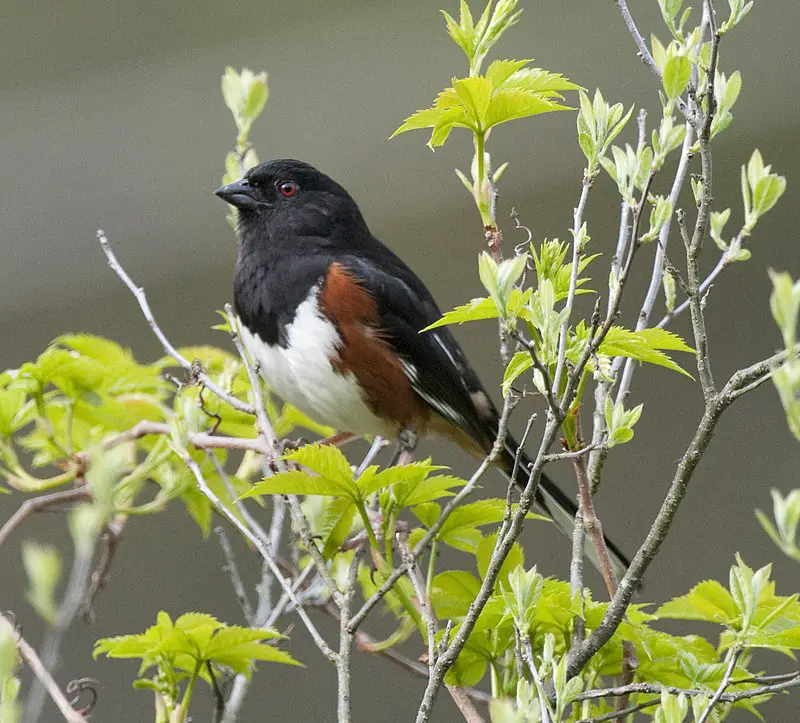
The Eastern Towhee is a large New World sparrow, native to brushy areas of eastern North America. These birds have distinct black and white markings, with chestnut brown underparts.
They nest either low in bushes or on the ground beneath shrubs. Northern towhees are known for migrating south during the winter months.
In recent decades, taxonomy debates have left some questioning whether this bird should remain its own species or be grouped together with the Spotted Towhee as one species — Rufous-sided Towhee.
This lively songbird has a bubbly personality and can often be seen hopping around on branches looking for food such as insects, fruits and seeds.Scientific classification:
| Kingdom | Animalia |
| Phylum | Chordata |
| Class | Aves |
| Order | Passeriformes |
| Family | Passerellidae |
| Genus | Pipilo |
| Species | P. erythrophthalmus |
20. Chipping Sparrow
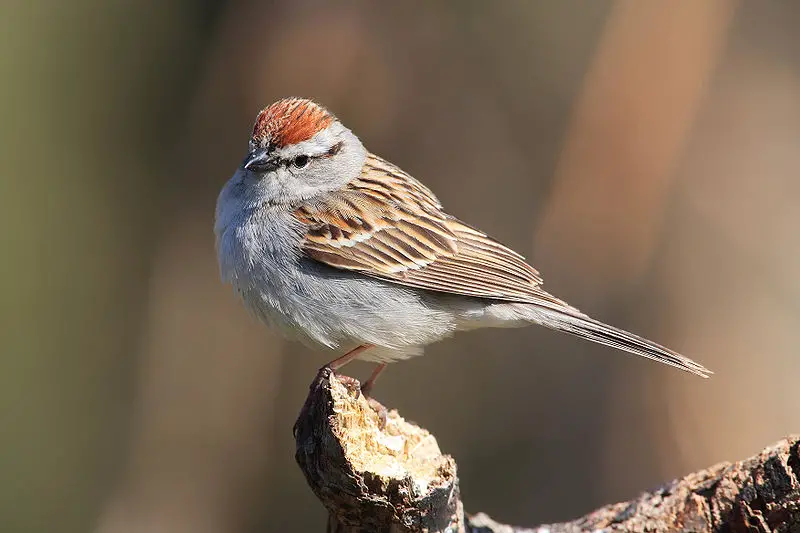
The Chipping Sparrow is a small passerine bird found across most of North America. It has two subspecies, the eastern and western chipping sparrows which migrate seasonally to overwinter in warmer climates.
The birds are grey above with white underparts, have a rufous cap with black stripes and large eyes surrounded by light brown feathers.
They feed mainly on seeds but can also be seen eating insects during breeding season when raising their young chicks.
These intrepid little birds live in open grasslands such as prairies or meadows where they build cup-shaped nests in trees or shrubs to raise their young family.
Their cheerful song often sounds like ‘chips’ hence its name; Chipping Sparrow.Scientific classification:
| Kingdom | Animalia |
| Phylum | Chordata |
| Class | Aves |
| Order | Passeriformes |
| Family | Passerellidae |
| Genus | Spizella |
| Species | S. passerina |
21. Pine Warbler
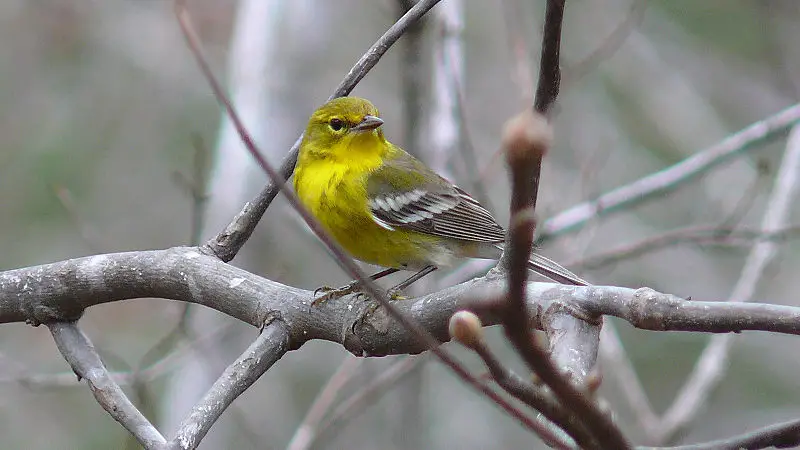
The Pine Warbler is a small bird from the New World warbler family, with an olive-brown upperparts and white belly.
Its distinguishing features include two white wing bars, dark legs, thin pointed bills and yellowish ‘spectacles’ around its eyes.
Adult males have bright yellow throats and breasts on top of their olive upperparts; females and immatures are less vibrant in colour but retain similar characteristics.
These birds can be found near pine forests throughout North America during summer months before migrating to warmer climates for winter.
They feed mainly on insects such as caterpillars, spiders and flies while also consuming fruits like blueberries when food becomes scarce in colder times of year.
All in all, these tiny songbirds provide us with much beauty through their unique plumage patterns whilst serving important roles within their ecosystems.Scientific classification:
| Kingdom | Animalia |
| Phylum | Chordata |
| Class | Aves |
| Order | Passeriformes |
| Family | Parulidae |
| Genus | Setophaga |
| Species | S. pinus |
22. Red-Winged Blackbird

The red-winged blackbird is a beautiful bird found in most of North America and Central America.
Its distinct features include a glossy black body, with white shoulder patches and bright red wing coverts year round.
It prefers wetland habitats such as marshes, ponds, lakeshores and agricultural fields. During breeding season they inhabit grassy areas near water then move south for the winter months.
For food they mainly eat insects but also consume wild fruit or grains.
They are very social birds often seen in large flocks during migration times when their unmistakable “conk-la-ree” call can be heard echoing across the sky.Scientific classification:
| Kingdom | Animalia |
| Phylum | Chordata |
| Class | Aves |
| Order | Passeriformes |
| Family | Icteridae |
| Genus | Agelaius |
| Species | A. phoeniceus |
23. Common Grackle

The Common Grackle is a large icterid bird commonly found in North America. It has an iridescent head and pale yellow eyes, which are framed by its long dark bill and long tail.
Males typically have more vivid colors on their heads than females do. These birds can be seen across much of the continent, in fields, forests, wetlands – even urban areas.
They form huge flocks to search for food such as grains or insects that they catch with their bills.
The grackles may also scavenge from human sources like garbage dumps or picnic tables if available. With its colorful plumage and distinct call it’s easy to spot this species amongst other birds.Scientific classification:
| Kingdom | Animalia |
| Phylum | Chordata |
| Class | Aves |
| Order | Passeriformes |
| Family | Icteridae |
| Genus | Quiscalus |
| Species | Q. quiscula |
24. Painted Bunting
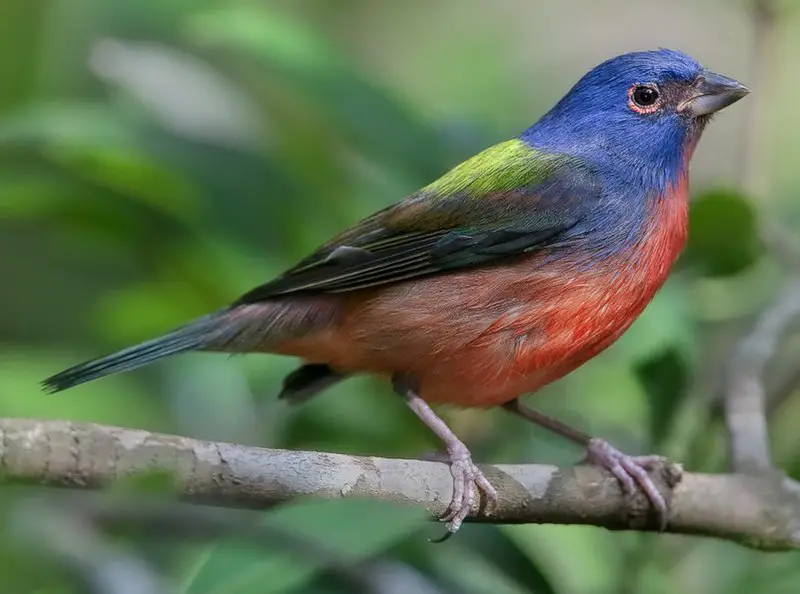
The Painted Bunting is an eye-catching bird from the Cardinal family, native to North America. It was first described by Carl Linnaeus in his eighteenth-century Systema Naturae.
The males of this species are particularly striking; they have brightly coloured plumage which only appears after their second year of life and can be distinguished from female birds through close inspection.
These colourful songbirds are a delight for any avid birder, with their vibrant hues bringing joy to nature lovers everywhere.
They often inhabit woodland areas where there is plenty of seed and insects available for them to feed on – as well as some shrubbery so that they can hide away safely when needed.Scientific classification:
| Kingdom | Animalia |
| Phylum | Chordata |
| Class | Aves |
| Order | Passeriformes |
| Family | Cardinalidae |
| Genus | Passerina |
| Species | P. ciris |
25. Brown-Headed Nuthatch
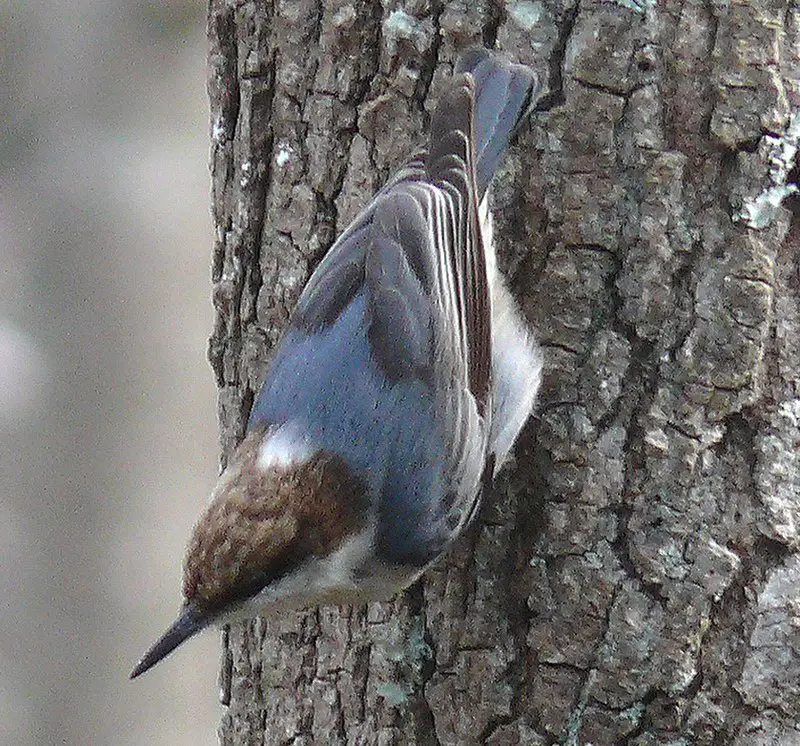
The brown-headed nuthatch is a small songbird native to pine forests in the southeastern US. With its brown head and blue-gray body, it’s easily recognizable.
Recent genetic analyses have revealed low differentiation between northern and southern populations in Florida, yet unfortunately lower genetic diversity among south Florida populations due to habitat fragmentation.
The Bahamas represent an isolated population of this species that may be at risk from human activity or other forms of disturbance such as hurricanes.
Conservation efforts will help ensure the protection of these birds for generations to come.Scientific classification:
| Kingdom | Animalia |
| Phylum | Chordata |
| Class | Aves |
| Order | Passeriformes |
| Family | Sittidae |
| Genus | Sitta |
| Species | S. pusilla |
26. Bluebirds
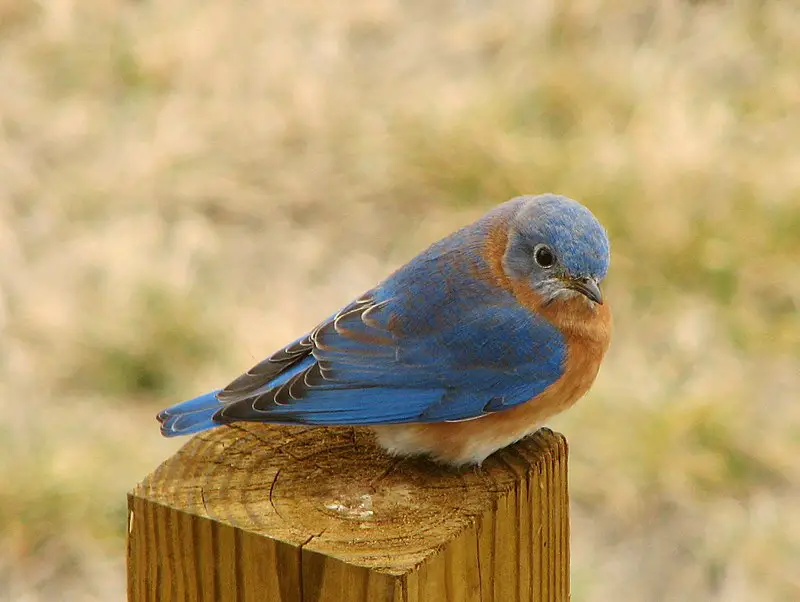
Bluebirds are a North American species of small to medium-sized birds belonging to the thrush family. They have stunning blue and rose beige plumage, with males having brighter colors than females.
These beautiful birds mainly feed on insects, but they can also eat some fruits or seeds from time to time. Bluebirds reside in open fields, meadows and backyards across much of North America.
Their cheerful songs bring joy as they fly through their habitats looking for food during the day before returning home at nightfall.
The sight of these beautiful creatures is often associated with happiness and hope – making them beloved by many people.Scientific classification:
| Kingdom | Animalia |
| Phylum | Chordata |
| Class | Aves |
| Order | Passeriformes |
| Family | Turdidae |
| Subfamily | Myadestinae |
| Genus | Sialia Swainson, 1827 |
27. White-Throated Sparrow

The White-throated Sparrow is a small passerine bird of the New World sparrow family Passerellidae.
It has distinctive yellow and black stripes on its head, white throat and chest with grey back and wings, along with light brown legs.
The scientific name “Zonotrichia albicollis” comes from Ancient Greek for ‘band’ (ζώνη) referring to its distinctive striped crown, and Latin for ‘white neck’ (albus collum).
These birds are usually found in wooded areas such as coniferous forests or deciduous habitats in North America where they feed mainly on insects during summer months; transitioning to seeds during winter.
They build their nests near ground level using grasses, twigs or moss lined with feathers.
White-throated Sparrows may be solitary but also form flocks when migrating southward each fall season which typically occurs over mid-late October through November depending on location within range.Scientific classification:
| Kingdom | Animalia |
| Phylum | Chordata |
| Class | Aves |
| Order | Passeriformes |
| Family | Passerellidae |
| Genus | Zonotrichia |
| Species | Z. albicollis |
28. Summer Tanager
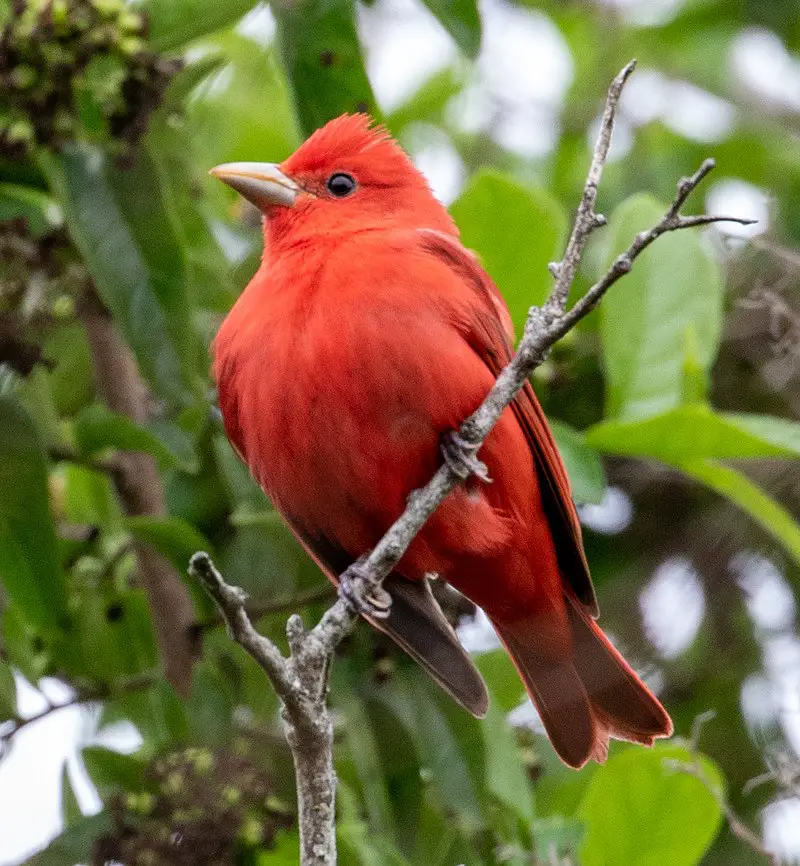
The Summer Tanager is a stunningly beautiful member of the cardinal family. Native to North and South America, this medium-sized songbird features striking red plumage on its back with yellow underparts.
It has a pointed black bill and long tail feathers that can be seen fluttering through the air when it flies.
The species’ vocalizations are quite similar to those of other members of its genus as well, which often include short whistles and chirps in addition to longer songs made up of various phrases or syllables.
With their vibrant colors and melodic voices, these birds make an eye-catching sight any time they appear.Scientific classification:
| Kingdom | Animalia |
| Phylum | Chordata |
| Class | Aves |
| Order | Passeriformes |
| Family | Cardinalidae |
| Genus | Piranga |
| Species | P. rubra |
29. Pileated Woodpecker
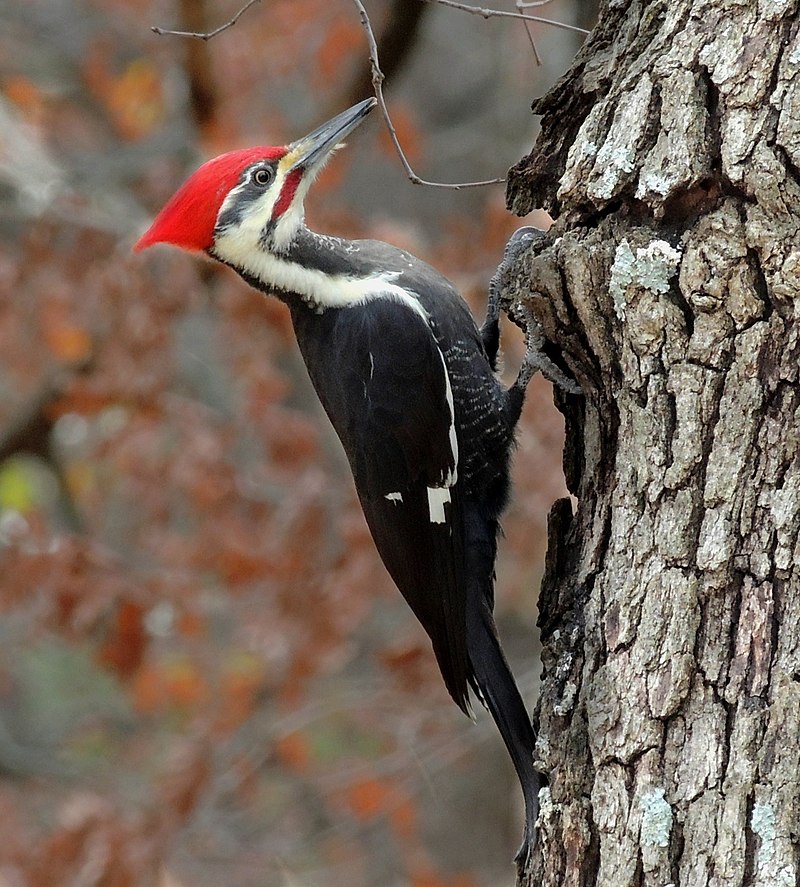
The pileated woodpecker is a large, majestic bird native to North America.
Its striking black plumage and red crest make it an unmistakeable sight in the forest canopy of deciduous forests across eastern North America, Great Lakes region, Canada’s boreal forests, and parts of the Pacific Coast.
It is one of the largest woodpeckers in North America: larger than any other confirmed species except for perhaps its relative; the ivory-billed woodpecker.
Insectivorous by nature, this stunning creature can be seen pecking away at tree trunks searching for food or making nest cavities – all with remarkable skill.
The pileated woodpecker truly stands out as a symbol of beauty and resilience amongst our avian wildlife.Scientific classification:
| Kingdom | Animalia |
| Phylum | Chordata |
| Class | Aves |
| Order | Piciformes |
| Family | Picidae |
| Genus | Dryocopus |
| Species | D. pileatus |
30. Song Sparrow

The Song Sparrow (Melospiza melodia) is a small, yet abundant bird found in North America.
They have brown upperparts with dark streaks and are white underneath, complete with a distinct dark brown spot on the breast.
Their cap is also brown and long roughed feathers can be seen sprouting from their neck area.
This sparrow species is highly variable and adaptable to many different environments including dry brush land, wetlands or open fields.
It has been noted that adult song sparrows will sing even during winter months when other birds remain quiet.
These energetic little animals make for great backyard companions as they flit about singing their lovely melodies.Scientific classification:
| Kingdom | Animalia |
| Phylum | Chordata |
| Class | Aves |
| Order | Passeriformes |
| Family | Passerellidae |
| Genus | Melospiza |
| Species | M. melodia |
31. Scarlet Tanager

The Scarlet Tanager is a beautiful medium-sized bird found in parts of North and South America. It belongs to the Cardinal family, and has striking red plumage with black wings and tail feathers.
Its song is similar to other cardinals yet also unique in its own way – it’s recognizable by its high whistles that become lower towards the end.
The species feeds mainly on insects as well as berries from trees or shrubs during breeding season, when they may form loose flocks over open woodlands foraging for food.
They are highly territorial birds during nesting season which happens between April and June each year; both males and females fiercely defend their nests against intruders such as cats or squirrels.Scientific classification:
| Kingdom | Animalia |
| Phylum | Chordata |
| Class | Aves |
| Order | Passeriformes |
| Family | Cardinalidae |
| Genus | Piranga |
| Species | P. olivacea |
32. Ruby-Throated Hummingbird

The ruby-throated hummingbird (Archilochus colubris) is a species of hummingbird that has an impressive migration pattern, spending the winter in Central America, Mexico and Florida before flying to Canada and other parts of Eastern North America for breeding season.
It’s by far the most common type seen east of the Mississippi River in North America.
Formally described by Swedish naturalist Carl Linnaeus in 1758, this tiny bird has bright metallic green upperparts with white underparts, a small black bill and a red throat patch which gives it its name; they measure around 3 inches long on average.
They feed primarily on nectar from flowers but also eat insects such as flies or mosquitoes for extra protein during their migrations or when raising young chicks.Scientific classification:
| Kingdom | Animalia |
| Phylum | Chordata |
| Class | Aves |
| Order | Apodiformes |
| Family | Trochilidae |
| Genus | Archilochus |
| Species | A. colubris |
33. Eastern Phoebe
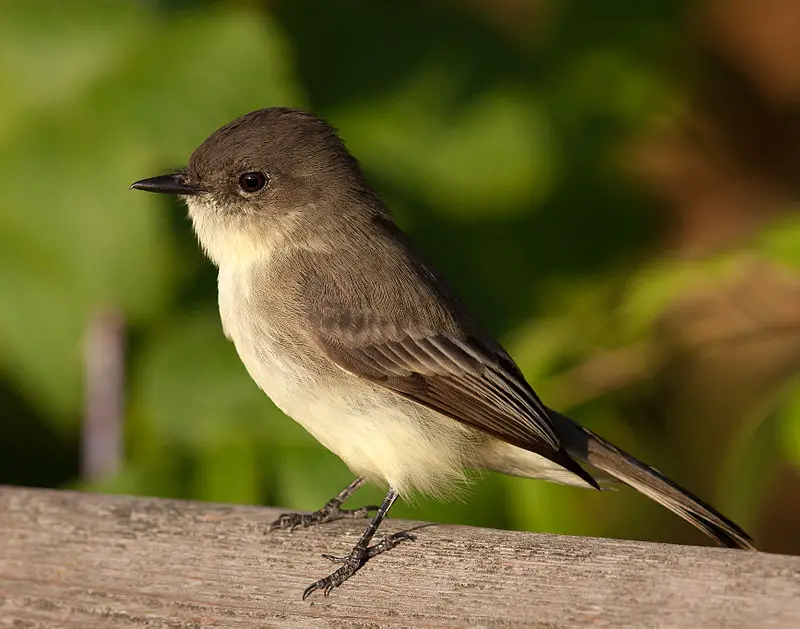
The Eastern Phoebe is a small passerine bird belonging to the genus Sayornis. It gets its name from Charles Lucien Bonaparte’s Muscicapa saya, and Ancient Greek ornis meaning “bird”.
The species’ alternative name ‘Phoebe’ comes from the Roman moon-goddess Diana, but also has been said to imitate their call.
Measuring up to 16 cm in length with a wingspan of 25–30 cm, they have grayish brown upperparts and pale underparts.
They are found near streams, woodlands and open fields where they hunt for insects such as flies, bees wasps etc., often catching them midair or by sallying out from perchs like branches or fences.
These birds make shallow cup nests made of grasses lined with mud which are built on cliffs ledges walls buildings bridges trees etc..
All in all this beautiful little bird is an interesting addition wherever you find it.Scientific classification:
| Kingdom | Animalia |
| Phylum | Chordata |
| Class | Aves |
| Order | Passeriformes |
| Family | Tyrannidae |
| Genus | Sayornis |
| Species | S. phoebe |
34. Red-Headed Woodpecker
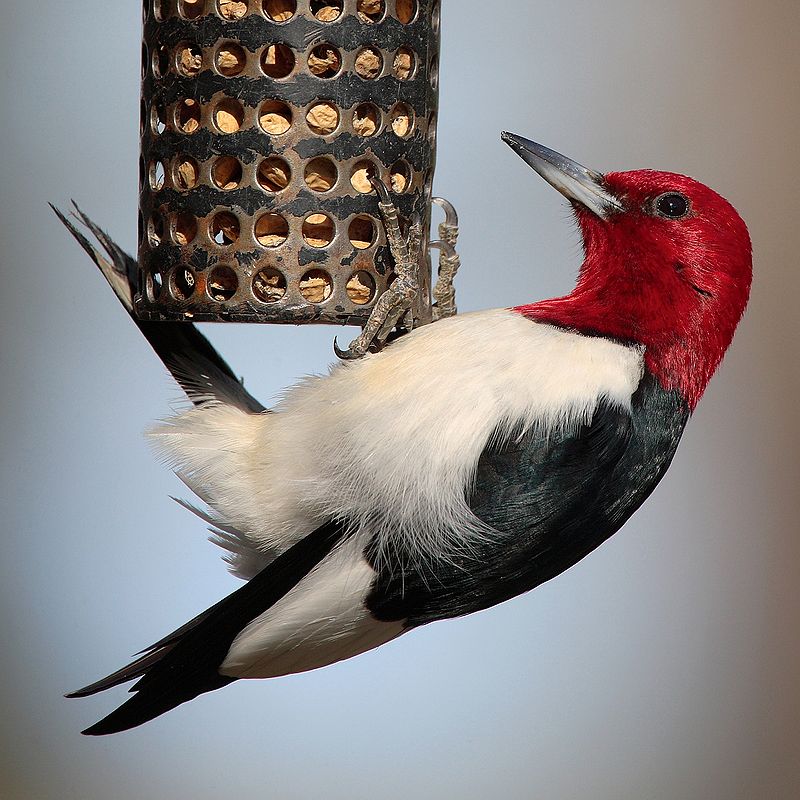
The red-headed woodpecker is a mid-sized bird found in temperate North America. It has striking plumage, with its head and neck being bright red while the rest of its body is primarily black and white.
Its wings are rounder than other similar species, allowing it to maneuver through tight spaces easily when searching for food or shelter.
The breeding habitat of this bird consists mainly of open fields across Canada and the east-central United States.
Despite facing threats such as deforestation, urbanization, predation from larger birds, collisions with windows or cars due to their inquisitive nature.
These birds remain listed on IUCN’s Red List as least concern thanks largely in part to conservation efforts by local governments and organizations dedicated to protecting wildlife habitats.Scientific classification:
| Kingdom | Animalia |
| Phylum | Chordata |
| Class | Aves |
| Order | Piciformes |
| Family | Picidae |
| Genus | Melanerpes |
| Species | M. erythrocephalus |
35. Dark-Eyed Junco

The Dark-eyed Junco is a species of small, grayish sparrows that are found across much of temperate North America and in the Arctic during summer.
It was formally described by Carl Linnaeus in 1766, who named it after its distinctive dark eyes.
This bird has a very variable appearance due to the many different subspecies it contains, making its systematics difficult to unravel.
The plumage varies from white or light gray on their underparts with slate grey backs and wings; black heads with white outer tail feathers; brown head stripes; yellow bills; pink legs and feet; as well as various shades between all these colours.
They also have considerable sexual dimorphism where males tend to be more colourful than females but share similar characteristics such as short tails and rounded bodies – both sexes being around 16 cm long when fully grown.Scientific classification:
| Kingdom | Animalia |
| Phylum | Chordata |
| Class | Aves |
| Order | Passeriformes |
| Family | Passerellidae |
| Genus | Junco |
| Species | J. hyemalis |
36. Ruby-Crowned Kinglet
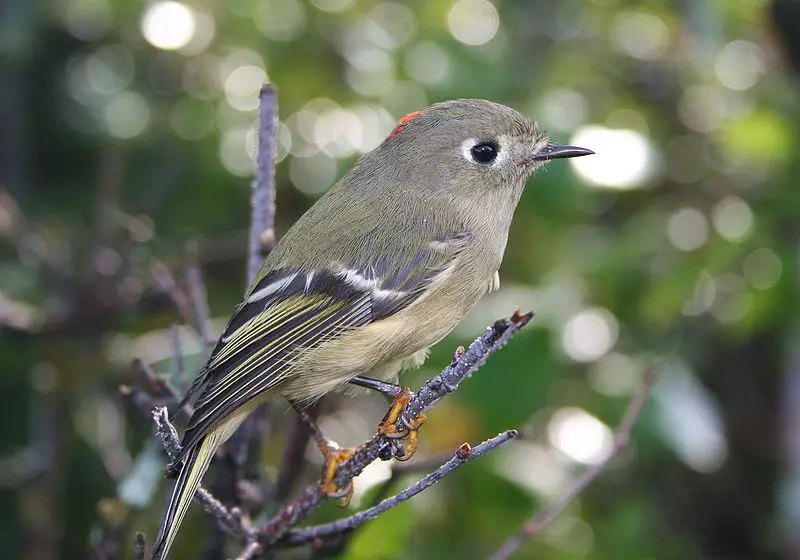
The Ruby-crowned Kinglet is a small passerine bird native to North America. It has olive green plumage, white wing bars and an eye-ring as well as a distinctive red crown patch on the males.
Juveniles look similar to adults with no distinguishing features other than size.
They are usually found in coniferous forests or woodlands where they spend much of their time searching for insects among foliage and branches while constantly flitting from place to place.
These birds have incredible energy levels that allow them to travel long distances during migration season without getting exhausted too quickly, making them one of nature’s most resilient species.Scientific classification:
| Kingdom | Animalia |
| Phylum | Chordata |
| Class | Aves |
| Order | Passeriformes |
| Family | Regulidae |
| Genus | Corthylio Cabanis, 1853 |
| Species | C. calendula |
37. Brown-Headed Cowbird
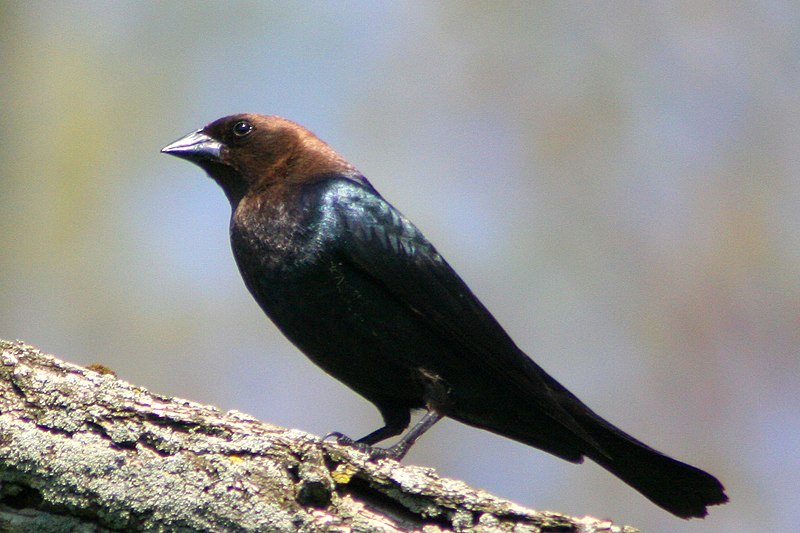
The Brown-headed Cowbird is a small, obligate brood parasitic icterid native to temperate and subtropical North America. It has a brown head with glossy black plumage on the body, wings and tail feathers.
During summer months it can be found in prairies, grasslands as well as open wooded areas but during winter they migrate southwards towards the United States of Mexico for warmer climate.
They are mainly insectivorous birds which feed on insects like caterpillars or beetles but also consume some grains too.
The female bird lays its eggs in nests of other species who then incubates them until hatching time thus leaving their own chicks uncared for by themselves.Scientific classification:
| Kingdom | Animalia |
| Phylum | Chordata |
| Class | Aves |
| Order | Passeriformes |
| Family | Icteridae |
| Genus | Molothrus |
| Species | M. ater |
38. Pine Siskin
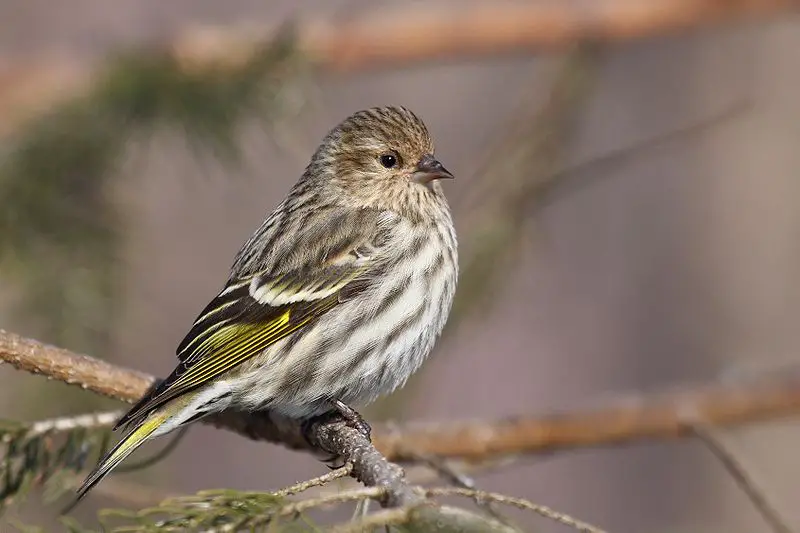
The Pine Siskin is a small bird from the finch family, primarily found in North America. It has an irregular migratory range and was first described by American ornithologist Alexander Wilson in 1810.
The species gets its name pinus, which means “pine-tree” in Latin, due to its frequent presence near coniferous trees.
Pine siskins are known for their yellow wing bars and streaked chests as well as their perky mannerisms when perched on branches or flying around looking for food during colder months.
They feed mostly on seeds of weeds, grasses and other plants but can also be seen consuming insects at times during summertime nesting season.
Its loud calls often alert nearby birds of potential danger while they nest high up among pine tree limbs where predators cannot reach them easily.Scientific classification:
| Kingdom | Animalia |
| Phylum | Chordata |
| Class | Aves |
| Order | Passeriformes |
| Family | Fringillidae |
| Subfamily | Carduelinae |
| Genus | Spinus |
| Species | S. pinus |
39. Canada Goose
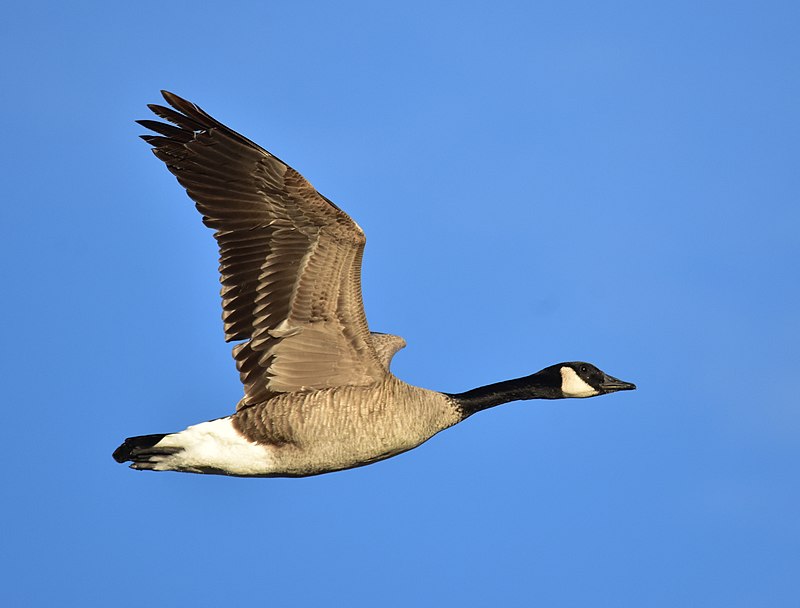
The Canada goose is a majestic bird with a black head and neck, white cheeks, chin and brown body. It’s native to North America but occasionally migrates to northern Europe across the Atlantic.
The species has been introduced in the United Kingdom, Ireland and Finland as well. Canada geese are strong flyers that travel in flocks for protection from predators; they also form monogamous pairs for life.
They feed on grasses or grains near ponds or wetlands where they make their nests of down which incubate eggs during summertime before hatching them out into goslings later on.Scientific classification:
| Kingdom | Animalia |
| Phylum | Chordata |
| Class | Aves |
| Order | Anseriformes |
| Family | Anatidae |
| Genus | Branta |
| Species | B. canadensis |
40. Rose-Breasted Grosbeak
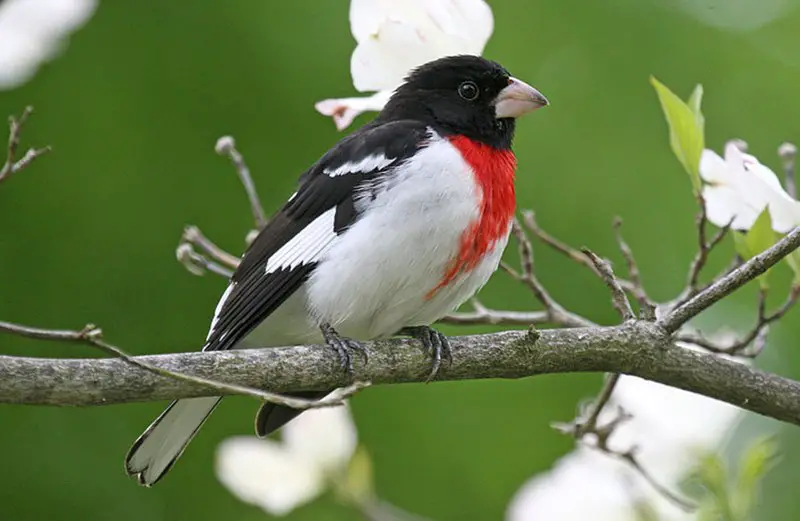
The Rose-breasted Grosbeak is a large, brightly coloured bird belonging to the Cardinal family. Males have black heads and wings, with white breasts boasting a bright rose patch.
Females are more muted in colouring being mostly buffy brown or greyish overall but still featuring the distinctive rose breast patch.The two sexes also exhibit marked sexual dimorphism.
These birds inhabit open woodlands across North America where they feed on seeds gleaned from foliage as well as fruits such as cherries and blueberries during their breeding season which runs from April through August each year.Scientific classification:
| Kingdom | Animalia |
| Phylum | Chordata |
| Class | Aves |
| Order | Passeriformes |
| Family | Cardinalidae |
| Genus | Pheucticus |
| Species | P. ludovicianus |
41. Indigo Bunting
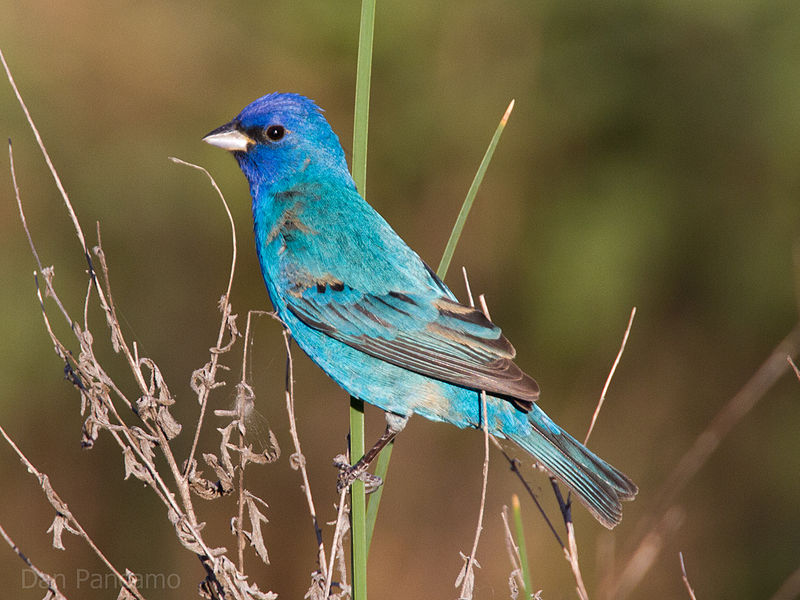
The Indigo Bunting is a small bird in the cardinal family, found throughout North and South America.
It has an unmistakable bright blue plumage that stands out against its natural habitat of farmland, brush areas and open woodland.
During breeding season it can be seen from southern Canada to northern Florida while during winter months it migrates south towards Central and Northern South America.
The Indigo Bunting prefers to migrate at night using the stars as navigation aids.
This species feeds on insects and seeds which they find near the ground or catch mid-flight with their agile wingspan.
An iconic sight for many farmers across both continents, these birds are a welcome addition to any backyard oasis or wildflower meadow.Scientific classification:
| Kingdom | Animalia |
| Phylum | Chordata |
| Class | Aves |
| Order | Passeriformes |
| Family | Cardinalidae |
| Genus | Passerina |
| Species | P. cyanea |
42. Yellow-Throated Warbler
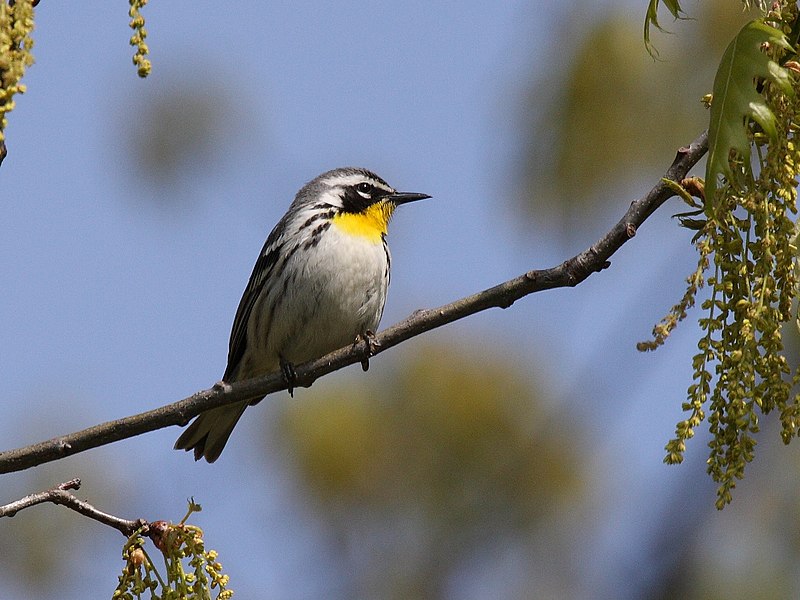
The Yellow-throated Warbler (Setophaga dominica) is a small migratory songbird found in temperate North America. It belongs to the Parulidae family of New World warblers.
Males have grey upperparts and wings with double white wing bars, yellow throats, and white underparts streaked with black on the flanks.
Females are less brightly colored, having olive green or brownish gray back and wings with two faint wingbars instead of one bright one visible in males.
These birds feed mainly on insects during their breeding season but will also eat fruits at other times of year while they migrate southwards for wintering grounds where they will search for nectar from flowers as well as fruit sources such as berries and wild grapes.
They can be seen actively searching through trees for food items near bird feeders during migration time periods making them an interesting species to observe.Scientific classification:
| Kingdom | Animalia |
| Phylum | Chordata |
| Class | Aves |
| Order | Passeriformes |
| Family | Parulidae |
| Genus | Setophaga |
| Species | S. dominica |
43. Red-Breasted Nuthatch

The Red-breasted Nuthatch is a beautiful and vocal songbird that can be found in coniferous forests across Canada, Alaska, the northeastern United States and western US.
This small bird has blue-grey upperparts with cinnamon underparts, a white throat and face with black eye stripe, straight grey bill and black crown.
Its call sounds like a tin trumpet; it’s high-pitched yet nasal.
During mating season they form monogamous pairs to build their nest near tree trunks or branches at low heights off the ground where they lay 2 – 8 eggs at once.
They are very active little birds who love clinging to trees while searching for insect larvae or seeds within the bark of trees which helps control pest populations.Scientific classification:
| Kingdom | Animalia |
| Phylum | Chordata |
| Class | Aves |
| Order | Passeriformes |
| Family | Sittidae |
| Genus | Sitta |
| Species | S. canadensis |
44. Orchard Oriole
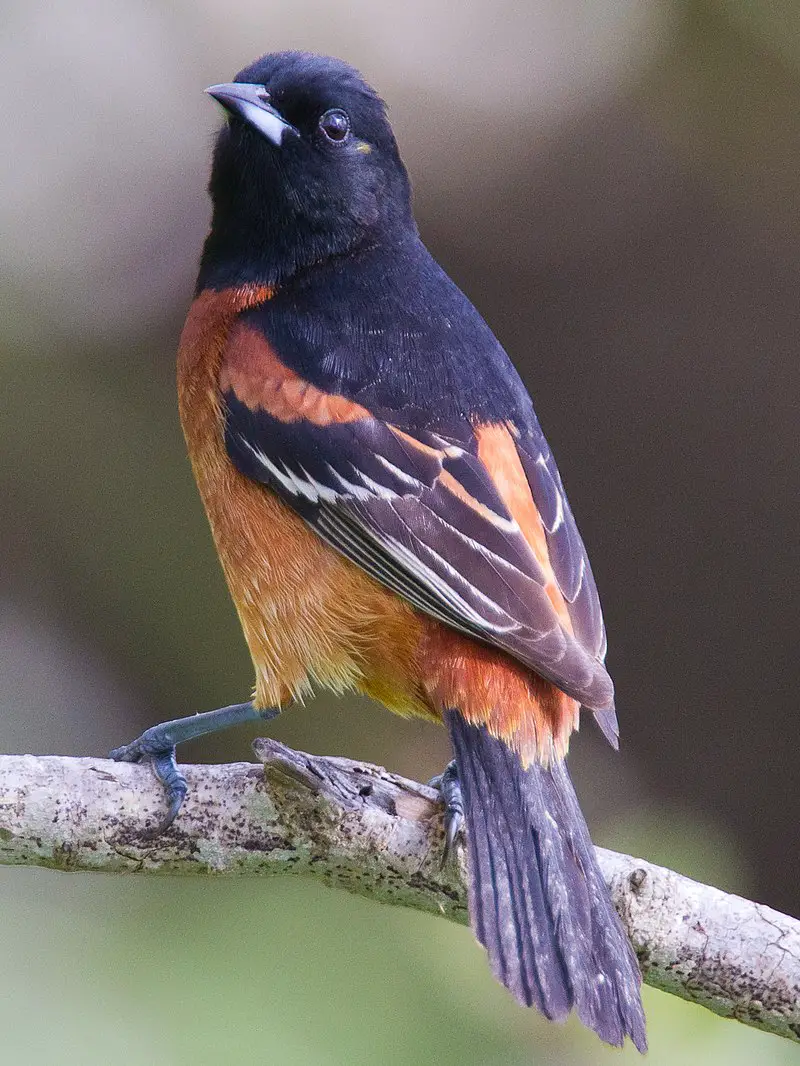
The Orchard Oriole is a small species of icterid bird, with the subspecies I. s. fuertesi sometimes considered its own separate species known as the Ochre or Fuertes’ Oriole.
The adult male of the nominate subspecies has chestnut upperparts and black wings and tail, while females are more yellowish-green in coloration on their back and wings.
Its bill is pointed, black in color with some blue-gray at the base of its lower mandible.
This beautiful bird can also be found across North America during migration season; they inhabit woodlands near streams or rivers to breed before migrating south for winter months.Scientific classification:
| Kingdom | Animalia |
| Phylum | Chordata |
| Class | Aves |
| Order | Passeriformes |
| Family | Icteridae |
| Genus | Icterus |
| Species | I. spurius |
45. Purple Finch

The Purple Finch is a species of finch from North America, belonging to the Fringillidae family.
It’s also known as an “American Rosefinch” due to its resemblance in color and size to some European rosefinches.
Their plumage ranges from pinkish-purple on their heads and wings, with a light brown underside.
They are small birds that measure about 5-6 inches long with short thin beaks for eating seeds and insects.
In addition, they have thick round bodies which help them stay warm during cold winters in the northern parts of their range.
The Purple Finch has adapted well over time making it easier for them to survive even though there are increasing threats posed by humans such as deforestation or habitat destruction caused by development projects near their habitats.Scientific classification:
| Kingdom | Animalia |
| Phylum | Chordata |
| Class | Aves |
| Order | Passeriformes |
| Family | Fringillidae |
| Subfamily | Carduelinae |
| Genus | Haemorhous |
| Species | H. purpureus |
46. Great Egret

The Great Egret is a large, white bird found in many regions of the world. It has four subspecies that reside across Asia, Africa, Americas and southern Europe.
This species usually lives near bodies of water such as lakes and marshes. They are also now starting to spread into more northern areas of Europe due to climate change.
These birds have long yellow legs with an impressive wingspan for their size which allows them to soar majestically through the sky hunting for fish or amphibians in shallow waters below.
Their feathers have been used historically by Native Americans as part of traditional garments or ceremonies but this practice should be avoided today so these amazing creatures can thrive without harm from humans.Scientific classification:
| Kingdom | Animalia |
| Phylum | Chordata |
| Class | Aves |
| Order | Pelecaniformes |
| Family | Ardeidae |
| Genus | Ardea |
| Species | A. alba |
47. Common Yellowthroat

The Common Yellowthroat is a small, New World Warbler found throughout North America. It has distinctive yellow and black plumage that earned it the nickname “Yellow Bandit” in the Midwest United States.
This species is highly adaptable and can be found inhabiting wetlands, grasslands, shrub-land habitats, as well as suburban areas.
The genus of this bird’s scientific name translates to mean ‘ground’ and ‘small bird’, which are fitting characteristics for such an elusive yet common little creature.
Its diet consists predominantly of insects but may also include other invertebrates like spiders or worms.
Overall the Common Yellowthroat makes an excellent addition to any backyard with its cheerful song.Scientific classification:
| Kingdom | Animalia |
| Phylum | Chordata |
| Class | Aves |
| Order | Passeriformes |
| Family | Parulidae |
| Genus | Geothlypis |
| Species | G. trichas |
48. Osprey
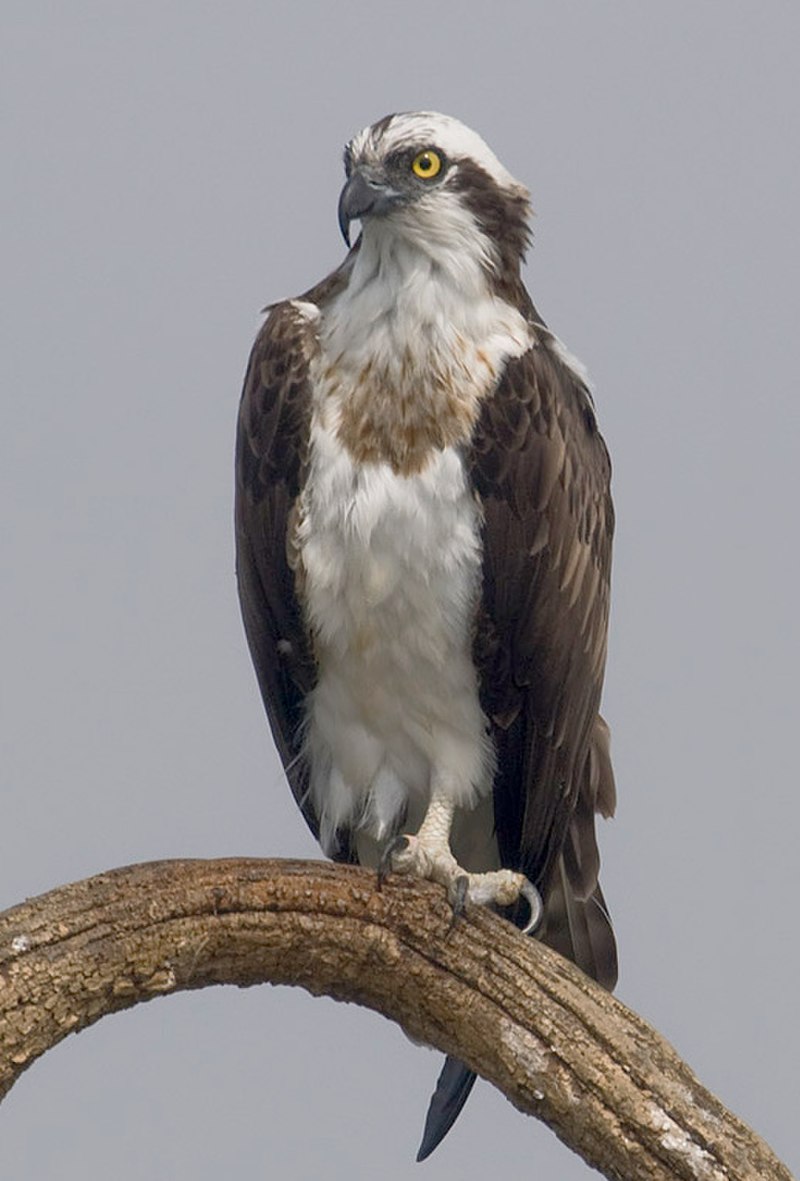
The Osprey is a majestic bird of prey with an incredibly wide habitat range. It has distinctive brown upperparts and greyish head and underparts, making it easily identifiable in the skies above many regions across the world.
With a wingspan of up to 180cm (71in) and body length reaching 60cm (24in), this large raptor specializes in hunting for fish, soaring high over rivers as well as coasts searching for its next meal.
Despite living near water sources, they can also be found inhabiting mountainsides or even woodlands, proving their incredible adaptability. An impressive species that truly deserves admiration.Scientific classification:
| Kingdom | Animalia |
| Phylum | Chordata |
| Class | Aves |
| Order | Accipitriformes |
| Family | Pandionidae |
| Genus | Pandion |
| Species | P. haliaetus |